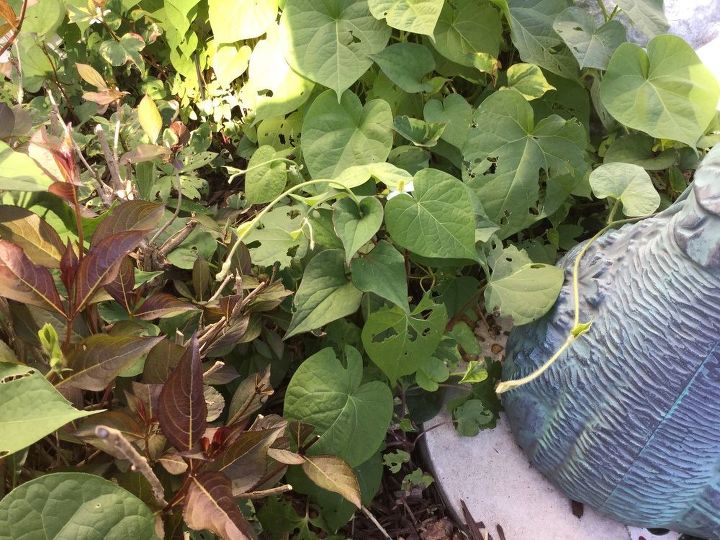How do I kill "wild" morning glorying? It is choking everything!
Related Discussions
GNATS - How to get rid of them?
Somehow my house and garden got tiny gnats that killed my fuchsia plant and fly everywhere. I have tried ALL the Web recommendations - soap and oil dishes, sand in th... See more
Marigolds growing! Should I pinch the buds?
My marigold plants are growing. I heard that pinching the buds until Autumn will allow them to grow without killing the plant. Is this true?
Growing garlic
Growing our first garlic, should we wait until the leaves are drying out before we pick it? Husband picked first one today along with our first potatoes.
How to keep mice out of your garden?
Hi everyone, I have mice in my garden destroying my vegetables and I have also noticed them in the barn and shed. Please can someone tell me how to prevent them from ... See more
What's the best flower/plant to grow in Texas?
I know that opinions vary, but what's your opinion?!I have great luck w Rosemary plants. Green all year long.




I just had this same question. I was told the only way was to pull it. It will choke everything you have and it's practically impossible to get rid of. They told me to pull it out by the roots and keep pulling.
Morning Glory vs. Bindweeds
Morning glory belongs to a family of unique and tenacious plants called Ipomoea. It is very closely related to the Convolvulus, or bindweed plants, which are perennial. Morning glory vine is an annual but reseeds itself so successfully you really wouldn’t know it.
The bindweed plants grow from rhizomes, or underground storage structures that promote the spread of the weed. They are hardy and tenacious, opportunistic weeds that get into cracks and crevasses and are nearly impossible to remove.
Many gardeners classify morning glory bindweeds as one type of plant. On the contrary, their separate taxonomy and growth patterns clearly identify the two as very different plants with similar flowers.
Morning Glory Vine Info
Another difference between morning glory and bindweed is the availability of the annual seeds and lack of access to bindweed seeds. Who would want to grow a weed that can visibly grow in a day, spreads over almost any surface and doesn’t die unless you apply chemicals?
Morning glory is more accommodating and the seeds are widely available in a host of colors. The slender stems grow rapidly and twist around each other for support. Flowers are funnel shaped, sometimes with a deeper or lighter throat. Garden supply centers carry the plant in pink, rose, purple, lavender, and white. The name morning glory vine stems from the flowers habit of opening in the first rays of morning light and closing when the full heat and sun of the day arrive.
Morning glory weeds in gardens are useful as ground covers, natural décor for fences and barriers, and beautifiers for that broken shed or barn that you still haven’t removed. Do be cautious where you plant this vine though, as it grows with an uncanny speed and can be very invasive and difficult to remove.
How to Kill Morning Glory
Many gardeners are confused and call morning glory bindweeds. While the plants are separate species, they do have similar stubborn growth habits and are difficult to eradicate just with pulling. Morning glory weed control is a multi-part task. Pre-emergent herbicides will not work on this plant and pulling is labor intensive and tends to just break the rhizome, which re-sprouts.
Completely removing the plants can be a maddening, many years long task. The use of thick mulches or weed barrier fabric can help smother the seedlings in spring. Do not allow the vines to flower and set seed, which will prevent some of the sprouts the following spring.
Glyphosate and some broad leaf herbicides have some effect, but you need to spray early in the season when the plants are young. Any systemic selective herbicide is a better choice, since Glyphosate will also affect surrounding plants. It is widely available, however, and painting it on the leaves helps prevent drift and surrounding plant injury. No matter which method you use, you will need to be vigilant and monitor for new plants and treat them.
vinegar! Carefully spray trying to avoid your favorite plants and give it a day or two to. Work and no more Morning glory
We have wild morning glories in an unused raised bed and I can attest that the root system is extensive, so just hand-pulling doesn't get them out. The roots are kinda stretchy, too. Lifting the soil with a shovel makes it fairly easy to shake the dirt off the roots. I turn the plants upside down on top of the compost heap and let the sun bake them.
The flowers are really pretty, though. They start out pink and turn white. Strangely, I've never been able to grow the domestic variety!
You need to find the source and kill at the roots. I would go so far as using agricultural strength vinegar and take the chance of losing a plant or two to be rid of it.